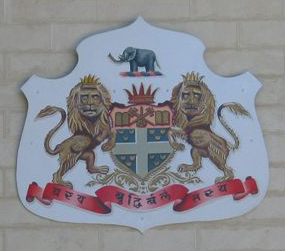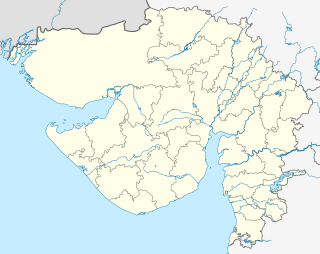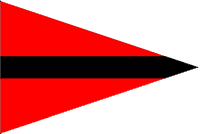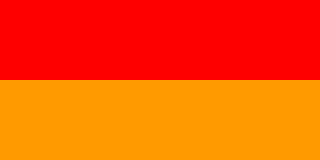
Maharaja Raol Sir Takhtsinhji JaswantsinhjiKIH, was Maharaja of Bhavnagar, a Rajput chief of the Gohil clan, and ruler of Bhavnagar state in Kathiawar. He succeeded to the throne of Bhavnagar upon the death of his father, Jaswantsinhji, in 1870.

The Rajkumar College in Rajkot, Gujarat is one of the oldest K-12 institutions in India. RKC has a 26-acre campus in Rajkot.
Ramgarh Raj was a major Zamindari estate in the era of the British Raj, in the former Indian province of Bihar. The estate was ruled by Narain Dynasty. Territories which comprised the Ramgarh Raj presently constitute districts of Ramgarh, Hazaribagh, Chatra, Giridih, Koderma, and Bokaro with 3672 villages. The entire area is rich in minerals like coal and mica and falls under the Indian State of Jharkhand. The First King was Maharaja Baghdeo Singh and the last ruling king was Maharaja Kamakhya Narain Singh of this estate, until the estate was merged to the Republic of India. The revenue of the estate was about 3600000 and the ruling family was the first family in India to use helicopters in election campaigns.

Patan is a town in the Indian state of Rajasthan. In the 12th century, it became the centre of a minor state called Tanwarawati or Torawati, ruled by a Tomar family. Anangpall II, who established the city of Patan and ruled present day Delhi. Anangpall II, is considered to be a direct descendant of Raja Parikshit, Son of Abhimanyu and Grandson of Arjuna. (Pandavas)

Loharu is a city, municipal committee and assembly constituency in the Bhiwani district of the Indian state of Haryana. It is the administrative headquarters of one of the four administrative sub-divisions of the district and covers 119 villages. It is also a railway junction station.

Devgadh Baria is a municipality in Dahod district in the state of Gujarat, India. It is a small town nestled in the foothills on the eastern border of Gujarat State. It is 40 kilometers from Godhra in the west, 54 kilometers from Dahod in the east and 14 kilometers south of Ahmedabad-Indore highway. Devgadh Baria is located on the bank of Panam River and is part of Dahod district in the state of Gujarat. The name, Devgadh Baria of the place derived two words Devgadh and Baria. Devgadh is the name of the mountain that is surrounding the town and Baria is the name of local tribe.

Maj. Gen. HH Maharaja Sawai Shri Sir Man Singh II GCSI GCIE was the last ruling Maharaja of Jaipur State. He ruled the princely state between 1922 and 1949, when the state acceded unto the Dominion of India. Thereafter, he held office as Rajpramukh of Rajasthan between 1949 and 1956. In later life, he served as Ambassador of India to Spain. He was also a notable sportsman and celebrated polo player.

Rao Raja Hanut Singh was a British Indian Army soldier and polo player.

The Narayan dynasty was the ruling family of Benares. After the disintegration of the Mughal Empire in the 18th century, the family ruled Benares as tributories of the Nawab of Awadh and the East India Company. In 1911, Benares became a full-fledged princely state of British India, and the Narayan dynasty ruled it as British vassals until they acceded to independent India in 1948.

Colonel Maharaja Raol Sir Shri Krishna Kumarsinhji Bhavsinhji KCSI was an Indian monarch and politician, the last Maharaja of the Gohil dynasty, who ruled Bhavnagar State from 1919 to 1948 and also served as the first Indian Governor of Madras from 1948 to 1952,After handover Rule of Bhavnagar State to Sardar Vallabhbhai Patel as part of Indian Union, and Bhavnagar is first state which joined Indian Union.

Bharatpur State was a princely state in the Indian subcontinent. It was ruled by the Sinsinwar clan of the Hindu Jats. They claimed descent from Madan Pal, a Yaduvanshi Kshatriya.

Bikaner State was a princely state in the Bikaner region from 1465 to 1947. The founder of the state, Rao Bika, was the eldest son of Rao Jodha, ruler of Jodhpur. Rao Bika chose to found his own kingdom instead of inheriting his father's. Bika defeated the Jat clans of Jangladesh and founded his own kingdom. Its capital was the city of Bikaner in the northern area of present-day Rajasthan State in India.

The Chhota Udaipur State or 'Princely State of Chhota Udaipur', was a princely state with its capital in Chhota Udaipur during the era of British India. The last ruler of Chhota Udaipur State signed the accession to join the Indian Union in 1948. Chhota Udepur shares a history with Devgadh Baria and Rajpipla as one of the three princely states of eastern Gujarat.

The Kingdom of Rajpipla or Rajpipla State was a princely state, with full internal jurisdiction, in India ruled by the Gohil Rajput dynasty for over 600 years from around 1340 till 1948. It was the largest State, and the only first-class State, of the Rewa Kantha Agency.. Among Gujarat States, Rajpipla State was the second-largest after Baroda in terms of size and importance. The Gohil Rajput dynasty of Rajpipla survived the onslaught of the Sultans of Ahmedabad and the Mughals during the mediaeval period, and the Gaekwars of Baroda and the British in the modern period, to emerge as a well-administered State with contemporary infrastructure, policies and practices by the time it was merged with the Union of India on 10th June 1948.

Baria State [The State of Baria], also known as Bariya State, was one of the princely states of India during the period of the British Raj. It was under the Rewa Kantha Agency of the Bombay Presidency and had its capital in Devgadh Baria town of present-day Dahod district in Gujarat state.
The line of succession to the former throne of Jodhpur, one of the pre-eminent Indian principalities, was by male primogeniture by the sons of Rajput mothers. Jodhpur State acceded to the Union of India in 1949.
The line of succession to the former throne of Idar, one of the principal Indian salute states, was by male primogeniture. Ruled by the Rathore Rajput clan, the former Idar State is now a constituent part of the Indian state of Gujarat.
Laiutenent Colonel Maharaj Kumar Dr. Basant Narain Singh was an Indian politician and a member of the 7th Lok Sabha representing Hazaribagh of Bihar State. He was regarded as the most prominent leader of Bihar at that time as throughout his life he never lost a single election. Did his M.R.A.S. (England), F.R.E.S., F.R.H.S. (London), M.A.M.N.H., M.N.G.S. (USA), educated at Rajkumar College, Raipur and at Mayo College, Ajmer. He belonged to the royal family of Ramgarh Raj and was from the Narain Dynasty.












